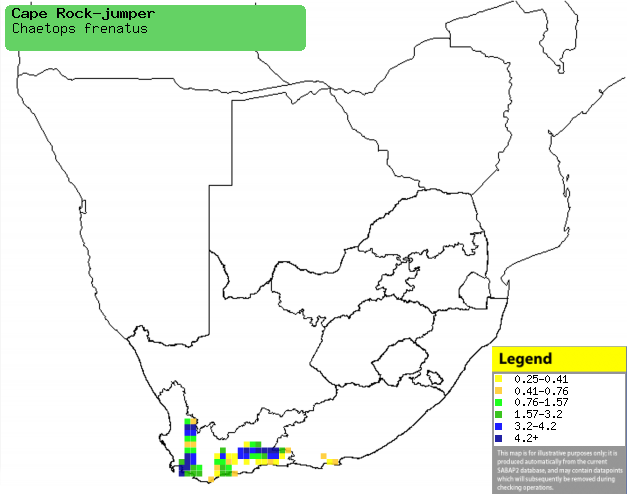|
Chaetops frenatus (Cape
rock-jumper)
Kaapse berglyster [Afrikaans]; Kaapse rotsspringer
[Dutch]; Chétopse bridé [French]; Kap-Felsenspringer [German];
Saxícola-do-Cabo [Portuguese]
Life
> Eukaryotes >
Opisthokonta
> Metazoa (animals) >
Bilateria >
Deuterostomia > Chordata >
Craniata > Vertebrata (vertebrates) > Gnathostomata (jawed
vertebrates) > Teleostomi (teleost fish) > Osteichthyes (bony fish) > Class:
Sarcopterygii (lobe-finned
fish) > Stegocephalia (terrestrial
vertebrates) > Tetrapoda
(four-legged vertebrates) > Reptiliomorpha > Amniota >
Reptilia (reptiles) >
Romeriida > Diapsida > Archosauromorpha > Archosauria >
Dinosauria
(dinosaurs) > Saurischia > Theropoda (bipedal predatory dinosaurs) >
Coelurosauria > Maniraptora > Aves
(birds) >
Order: Passeriformes > Family: Chaetopidae
Distribution and habitat
Endemic to South Africa, occurring from Uitenhage, Eastern
Cape to Cape Hanklip (absent from the Cape peninsula), north to the Cedarberg
mountains and Piketberg. It generally prefers rocky mountain fynbos especially
on high, windswept slopes and ridges, but it has occasionally been reported at
sea level in the Western Cape.
|
 |
|
Distribution of Cape rockjumper in southern Africa,
based on statistical smoothing of the records from first SA Bird Atlas
Project (©
Animal Demography unit, University of
Cape Town; smoothing by Birgit Erni and Francesca Little). Colours range
from dark blue (most common) through to yellow (least common).
See here for the latest distribution
from the SABAP2. |
Food
It mainly eats arthropods, supplemented with reptiles and
rarely amphibians. Most foraging is done on the ground, pecking and scratching
the sand at the base of rocks or bushes in search of prey.
Breeding
- It is a monogamous, facultative cooperative breeder, meaning that the
breeding pair are occasionally assisted by up to three helpers, who are
either non-breeding adults or offspring from the previous breeding season.
If its territory is intruded upon it takes an upright stance on top of a
rock, often cocking and fanning its tail while calling.
- Egg-laying season is from late July-January, peaking around
September-October.
- It lays 2 eggs, which are incubated by both sexes for about 19-21 days.
Helpers have not been observed during this period, but they probably assist
the breeding pair with incubation.
- The chicks are fed a variety of prey items by their parents and
sometimes helpers. They leave the nest at about 18-21 days, but it takes
approximately 5 more days for them two learn to fly and feed for themselves.
They remain in the parents territory for at least 3 weeks before becoming
fully independent.
Threats
Not threatened, although encroaching alien vegetation on
its primary habitat is cause for concern.
References
-
Hockey PAR, Dean WRJ and Ryan PG 2005. Roberts
- Birds of southern Africa, VIIth ed. The Trustees of the John Voelcker
Bird Book Fund, Cape Town.
|
